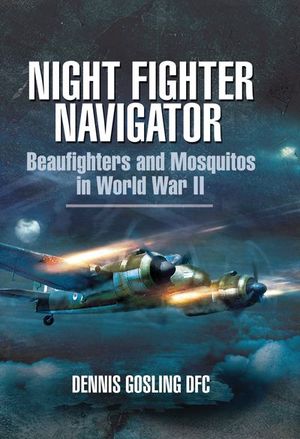Night Fighter Navigator
Published by Pen & Sword Books
A British Royal Air Force navigator shares his experiences during World War II in this compelling memoir.
Yorkshireman Dennis Gosling joined the RAF on 24 May 1940. Having completed his training, he was posted to 219 Squadron flying the night-fighter version of the Beaufighter from Tangmere in 1941. As a navigator, he became part of a two-man team that would endure throughout his first operational tour. In those infant days of radar interception, he honed his skills in the night skies above southern England and the English Channel but without a firm kill. On 12 February 1942, he and his pilot were instructed to pick up a brand-new aircraft and deliver it to North Africa, flying via Gibraltar, a hazardous flight at extreme range. In March the crew were posted to 1435 Flight of 89 Squadron with the task of defending the besieged island of Malta.
The flight’s four Beaufighters flew into incessant bombing raids by the Luftwaffe and Italian Air Force. Because of these raids the damage to aircraft on the ground was devastating and the flight was often reduced to a single serviceable aircraft. Gosling’s first success came in April 1942 with a confirmed kill, and then shortly after his twenty-first birthday on 13 May, a triumphant night on the seventeenth brought three certain kills and one damaged enemy aircraft. After being the squadron’s virgins, they shot into the record books—Gosling’s pilot being awarded the DFC. Flight Sergeant Gosling, however, received no award. At this stage he became somewhat embittered by the class system he felt was operated by the RAF. Having endured the torment of constant bombardment, serious stomach complaints (even flying with a bucket in the aircraft) and near starvation, he completed his tour and was repatriated to the UK via Brazil and Canada in the Queen Mary.
After a spell instructing new night navigators, he joined 604 Squadron and in December 1943 he was promoted to Warrant Officer. February 1944 saw the squadron reequipped with the Mosquito and assignment to 2 Tactical Air Force in preparation for D-Day. Now once again he was flying initially over southern England and the Channel. The squadron became mobile after the landings and were based in various captured airfields in France, but the conditions were so inadequate for operations that the squadron returned to English bases, from where they operated over and beyond the advancing Allied troops. Eventually, after having been awarded a much-deserved DFC, he accepted the King’s Commission.
This autobiography is written as stated by the author, “I want my readers to relive my experiences as they happened to me—to take their hands and have them walk beside me. I want them to feel the joy and the pain, share the laughs and the heartache, take pleasure in the triumphs, agonise with me when things went wrong and understand why my Service years influenced so much of my life.” He has succeeded magnificently
Yorkshireman Dennis Gosling joined the RAF on 24 May 1940. Having completed his training, he was posted to 219 Squadron flying the night-fighter version of the Beaufighter from Tangmere in 1941. As a navigator, he became part of a two-man team that would endure throughout his first operational tour. In those infant days of radar interception, he honed his skills in the night skies above southern England and the English Channel but without a firm kill. On 12 February 1942, he and his pilot were instructed to pick up a brand-new aircraft and deliver it to North Africa, flying via Gibraltar, a hazardous flight at extreme range. In March the crew were posted to 1435 Flight of 89 Squadron with the task of defending the besieged island of Malta.
The flight’s four Beaufighters flew into incessant bombing raids by the Luftwaffe and Italian Air Force. Because of these raids the damage to aircraft on the ground was devastating and the flight was often reduced to a single serviceable aircraft. Gosling’s first success came in April 1942 with a confirmed kill, and then shortly after his twenty-first birthday on 13 May, a triumphant night on the seventeenth brought three certain kills and one damaged enemy aircraft. After being the squadron’s virgins, they shot into the record books—Gosling’s pilot being awarded the DFC. Flight Sergeant Gosling, however, received no award. At this stage he became somewhat embittered by the class system he felt was operated by the RAF. Having endured the torment of constant bombardment, serious stomach complaints (even flying with a bucket in the aircraft) and near starvation, he completed his tour and was repatriated to the UK via Brazil and Canada in the Queen Mary.
After a spell instructing new night navigators, he joined 604 Squadron and in December 1943 he was promoted to Warrant Officer. February 1944 saw the squadron reequipped with the Mosquito and assignment to 2 Tactical Air Force in preparation for D-Day. Now once again he was flying initially over southern England and the Channel. The squadron became mobile after the landings and were based in various captured airfields in France, but the conditions were so inadequate for operations that the squadron returned to English bases, from where they operated over and beyond the advancing Allied troops. Eventually, after having been awarded a much-deserved DFC, he accepted the King’s Commission.
This autobiography is written as stated by the author, “I want my readers to relive my experiences as they happened to me—to take their hands and have them walk beside me. I want them to feel the joy and the pain, share the laughs and the heartache, take pleasure in the triumphs, agonise with me when things went wrong and understand why my Service years influenced so much of my life.” He has succeeded magnificently
BUY NOW FROM
COMMUNITY REVIEWS
